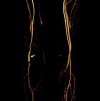Popliteal Artery Injury After Arthroscopic Knee Surgery: A Retrospective Multicenter Cohort Study
- PMID: 39736076
- PMCID: PMC11872355
- DOI: 10.1111/os.14334
Popliteal Artery Injury After Arthroscopic Knee Surgery: A Retrospective Multicenter Cohort Study
Abstract
Objective: Popliteal artery injury is a rare but serious complication of arthroscopic knee surgery. The absence of comprehensive data and standardized guidelines underscores the urgent need for further investigation. This study examines the incidence, risk factors, management strategies, and long-term outcomes of popliteal artery injury in the context of arthroscopic knee procedures.
Methods: We conducted a retrospective cohort study utilizing data from 21 medical institutions in Hunan Province, China, from January 2018 to December 2022. We identified patients who underwent arthroscopic knee surgery and complained of postsurgical popliteal artery injury. Patients were followed up for 43.1 ± 13.23 months (ranging from 22 to 58 months). The primary outcome was joint function, which was evaluated by a postoperative range of motion (ROM), International Knee Documentation Committee (IKDC) scores, Lysholm knee scores, and Visual Vascular Quality of Life Questionnaire (VascuQoL) scores. These data from different postoperative periods were compared via paired t-test to assess postoperative recovery. The secondary outcome was vascular patency of the affected limb, which was evaluated through vascular color Doppler ultrasound.
Results: Among the 17,000 knee arthroscopic procedures analyzed, 10 patients were identified with popliteal artery injury (0.059%). The surgeries performed included arthroscopic cystectomy for popliteal cysts, cruciate ligament reconstruction, and posterior horn of the lateral meniscus repair. Treatments for popliteal artery injury included percutaneous intravascular stent implantation (one patient), direct suture repair (four patients), allograft vascular transplantation (one patient), and reconstruction with an autogenous greater saphenous vein (four patients). After a mean follow-up time of 43.1 ± 13.23 months (ranging from 22 to 58 months), no complications were reported. Compared with patients at 1 month after surgery, patients at 2 years after surgery presented improved knee function and ROM. The average Lysholm score increased significantly from 13.8 ± 4.21 to 68.2 ± 15.50, the IKDC score increased from 11.6 ± 2.46 to 48.1 ± 11.75, and the VascuQoL score improved from 54.8 ± 9.54 to 92.5 ± 15.90. Knee extension improved from 13.3° ± 2.36° to 3.5° ± 4.12°, and knee flexion increased from 49.5° ± 12.57° to 107° ± 21.63°. All patients successfully resumed daily activities postoperatively.
Conclusion: Popliteal artery injury is a catastrophic complication that warrants significant attention during knee arthroscopy. This injury can occur in various types of arthroscopic knee procedures. Prompt diagnosis and effective intervention are crucial for minimizing the potential detriment associated with popliteal artery injury.
Keywords: arthroscopic knee surgery; endovascular treatment; popliteal artery injury.
© 2024 The Author(s). Orthopaedic Surgery published by Tianjin Hospital and John Wiley & Sons Australia, Ltd.
Conflict of interest statement
The authors declare no conflicts of interest.
Figures





Similar articles
-
[Traumatic knee dislocation with popliteal vascular disruption: retrospective study of 14 cases].Rev Chir Orthop Reparatrice Appar Mot. 2006 Dec;92(8):768-77. doi: 10.1016/s0035-1040(06)75945-1. Rev Chir Orthop Reparatrice Appar Mot. 2006. PMID: 17245236 French.
-
[Application of anterior region suture of popliteal hiatus in treatment of discoid lateral meniscus injury with instability in popliteal tendon region].Zhongguo Xiu Fu Chong Jian Wai Ke Za Zhi. 2024 Mar 15;38(3):272-277. doi: 10.7507/1002-1892.202312007. Zhongguo Xiu Fu Chong Jian Wai Ke Za Zhi. 2024. PMID: 38500418 Free PMC article. Chinese.
-
[Clinical study on treatment of complete radial tear of meniscus using arthroscopic All-inside single needle vertical suture technique].Zhongguo Xiu Fu Chong Jian Wai Ke Za Zhi. 2025 May 15;39(5):550-555. doi: 10.7507/1002-1892.202502044. Zhongguo Xiu Fu Chong Jian Wai Ke Za Zhi. 2025. PMID: 40368856 Free PMC article. Chinese.
-
[Vascular injury as a complication of knee arthroscopic surgery. Report of two cases and review of the literature].Cir Cir. 2013 Sep-Oct;81(5):454-8. Cir Cir. 2013. PMID: 25125066 Review. Spanish.
-
Single-stage repair of displaced bucket-handle meniscal tears with anterior cruciate ligament reconstruction leads to good meniscal survivorship : a retrospective cohort study.Bone Joint J. 2022 Jun;104-B(6):680-686. doi: 10.1302/0301-620X.104B6.BJJ-2021-1340.R2. Bone Joint J. 2022. PMID: 35638209 Review.
Cited by
-
A novel Z-shaped anti-rotation rod for atlantoaxial dislocation reduction: finite element analysis.J Orthop Surg Res. 2025 Apr 29;20(1):428. doi: 10.1186/s13018-025-05723-1. J Orthop Surg Res. 2025. PMID: 40301988 Free PMC article.
-
Comparative analysis of the correlation between paraspinal muscles fat infiltration and vertebral bone quality in patients with lumbar degenerative diseases.Eur Spine J. 2025 Jul 14. doi: 10.1007/s00586-025-09142-y. Online ahead of print. Eur Spine J. 2025. PMID: 40659966
References
-
- Hagino T., Ochiai S., Watanabe Y., et al., “Complications After Arthroscopic Knee Surgery,” Archives of Orthopaedic and Trauma Surgery 134 (2014): 1561–1564. - PubMed
-
- Abram S. G. F., Judge A., Beard D. J., Wilson H. A., and Price A. J., “Temporal Trends and Regional Variation in the Rate of Arthroscopic Knee Surgery in England: Analysis of Over 1.7 Million Procedures Between 1997 and 2017. Has Practice Changed in Response to New Evidence?,” British Journal of Sports Medicine 53 (2019): 1533–1538. - PubMed
-
- Salzler M. J., Lin A., Miller C. D., Herold S., Irrgang J. J., and Harner C. D., “Complications After Arthroscopic Knee Surgery,” American Journal of Sports Medicine 42 (2014): 292–296. - PubMed
Publication types
MeSH terms
LinkOut - more resources
Full Text Sources
Medical

